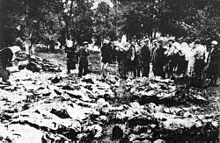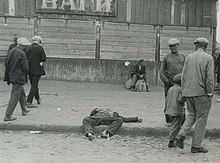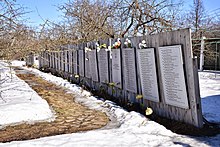Excess mortality in the Soviet Union under Joseph Stalin

Estimates of the number of deaths attributable to the Soviet revolutionary and dictator
Before the
Events

Gulag
According to official Soviet estimates, more than 14 million people passed through the Gulag from 1929 to 1953, and a further 7 to 8 million were
According to a 1993 study of recently declassified archival Soviet data, a total of 1,053,829 people died in the Gulag (not including labor colonies) from 1934 to 1953 (there was no archival data for the period 1919–1934).[17]: 1024 More recent archival figures for the deaths in the Gulag, labor colonies and prisons combined for 1931–1953 were 1.713 million.[15] According to historian Michael Ellman, non-state estimates of the actual Gulag death toll are usually higher because historians such as Robert Conquest took into account the likelihood of unreliable record keeping.[18] According to author Anne Applebaum, it was common practice to release prisoners who were either suffering from incurable diseases or near death.[19]
Golfo Alexopoulos, history professor at the University of South Florida, believes that at least six million people died as a result of their detention in the gulags.[20] This estimate is disputed by other scholars, with critics such as J. Hardy stating that the evidence Alexopoulos used is indirect and misinterpreted.[21] Historian Dan Healey argues that the estimate has obvious methodological difficulties.[22][failed verification]
Citing materials pre-1991, author John G. Heidenrich estimates the number of deaths at 12 million.[23][undue weight? ] His book is not primarily about estimating deaths from repressive policies in the Soviet Union, and he appears to have relied on Aleksandr Solzhenitsyn's political and literary work The Gulag Archipelago, which historian Stephen G. Wheatcroft explains was not intended as a historical fact but as a challenge to Soviet authorities after their years of secrecy.[24]
According to estimates based on data from Soviet archives post-1991, there were around 1.6 million deaths during the whole period from 1929 to 1953.[25] The tentative historical consensus is that of the 18 million people who passed through the gulag system from 1930 to 1953, between 1.5 and 1.7 million died as a result of their incarceration.[22]
Soviet famine of 1932–1933
The deaths of 5.7
Judicial executions
According to official figures there were 777,975 judicial executions for political charges from 1929 to 1953, including 681,692 in 1937–1938, the years of the Great Purge.[9] Unofficial estimates estimate a total number of Stalinism repression deaths in 1937–38 at 700,000–1,200,000.[45][46] There were also operations of mass ethnic cleansing against various minorities living in Stalin's USSR, known as the National operations of the NKVD, with the largest one being the Polish Operation of the NKVD during which over 111,000 Polish communists and other Poles were exterminated.
Soviet famine of 1946–1947
The last major famine to hit the Soviet Union began in July 1946, reached its peak in February–August 1947 and then quickly diminished in intensity, although there were still some famine deaths in 1948.[47] Economist Michael Ellman states that the hands of the state could have fed all those who died of starvation. He argues that had the policies of the Soviet regime been different, there might have been no famine at all or a much smaller one. Ellman claims that the famine resulted in an estimated 1 to 1.5 million lives lost in addition to secondary population losses due to reduced fertility.[47]
Population transfer by the Soviet Union
Deportation of kulaks
Large numbers of kulaks regardless of their nationality were resettled to Siberia and Central Asia. According to data from Soviet archives, which were published in 1990, 1,803,392 people were sent to labor colonies and camps in 1930 and 1931, and 1,317,022 reached the destination. Deportations on a smaller scale continued after 1931. Data from the Soviet archives indicates 2.4 million kulaks were deported from 1930 to 1934.[48] The reported number of kulaks and their relatives who had died in labour colonies from 1932 to 1940 was 389,521.[11][49] Popular history author Simon Sebag Montefiore estimated that 15 million kulaks and their families were deported by 1937; during the deportation, many people died, but the full number is not known.[50]
Forced settlements in the Soviet Union of 1939–1953

According to Russian historian
Katyn massacre
The massacre was prompted by NKVD chief
Total number of victims


Census data
Writing in
Modern estimates
Some historians claim that the death toll was around 20 million,
Historians such as
Some historians believe that the official archival figures of the categories that were recorded by Soviet authorities are unreliable and incomplete.
| Event | Est. number of deaths | References |
|---|---|---|
| Dekulakization | 530,000–600,000 | [81] |
| Great Purge | 700,000–1,200,000 | [45][9][46] |
| Gulag | 1,500,000–1,713,000 | [15][22] |
Soviet deportations |
450,000–566,000 | [82][83] |
| Katyn massacre | 22,000 | [84] |
| Holodomor | 2,500,000–4,000,000 | [85] |
Kazakh famine of 1931–33 |
1,450,000 | [86] |
Genocide allegations

Stalin has been accused of
Contemporary historians classify these deportations as a
Historians continue to debate whether or not the 1932–33 Ukrainian famine, known in Ukraine as the
See also
- Day of Remembrance of the Victims of Political Repressions
- Mass killings under communist regimes
- Political repression in the Soviet Union
- World War II casualties of the Soviet Union
References
- ^ a b "Soviet Studies". See also: Gellately (2007) p. 584: "Anne Applebaum is right to insist that the statistics 'can never fully describe what happened.' They do suggest, however, the massive scope of the repression and killing."
- ^ JSTOR 152781.
The Stalinist regime was consequently responsible for about a million purposive killings, and through its criminal neglect and irresponsibility it was probably responsible for the premature deaths of about another two million more victims amongst the repressed population, i.e. in the camps, colonies, prisons, exile, in transit and in the POW camps for Germans. These are clearly much lower figures than those for whom Hitler's regime was responsible.
- ^ S2CID 205667754.
- ISSN 0002-8762.
New studies using declassified Gulag archives have provisionally established a consensus on mortality and "inhumanity."
- ^ Robert Conquest. The Great Terror. NY Macmillan, 1968 p. 533 (20 million)
- Anton Antonov-Ovseyenko, The Time of Stalin, NY Harper & Row 1981. p. 126 (30–40 million)
- ^ Elliot, Gill. Twentieth Century Book of the Dead. Penguin Press 1972. pp. 223–24 (20 million)
- ^ Seumas Milne: "The battle for history", The Guardian. (12 September 2002). Retrieved 14 July 2013.
- ^ ISBN 978-0745319308.
- ISBN 0767900561pp. 582–583.
- ^ ISBN 0786403365.
- ISBN 0786403365. Pohl cites Russian archival sources for the death toll in the special settlements from 1941–49
- .
During 1921–53, the number of sentences was (political convictions): sentences, 4,060,306; death penalties, 799,473; camps and prisons, 2,634397; exile, 413,512; other, 215,942. In addition, during 1937–52 there were 14,269,753 non-political sentences, among them 34,228 death penalties, 2,066,637 sentences for 0–1 year, 4,362,973 for 2–5 years, 1,611,293 for 6–10 years, and 286,795 for more than 10 years. Other sentences were non-custodial
- ISBN 978-0230238558.
- ^ S2CID 43510161.
- .
We are all inclined to accept the Zemskov totals (even if not as complete) with their 14 million intake to Gulag 'camps' alone, to which must be added 4–5 million going to Gulag 'colonies', to say nothing of the 3.5 million already in, or sent to, 'labour settlements'. However taken, these are surely 'high' figures.
- JSTOR 2166597.
- S2CID 43510161.
- ISBN 0767900561. p. 583: "... both archives and memoirs indicate that it was common practice in many camps to release prisoners who were on the point of dying, thereby lowering camp death statistics."
- ISBN 978-0300179415.
- ^ .
New studies using declassified Gulag archives have provisionally established a consensus on mortality and 'inhumanity.' The tentative consensus says that once secret records of the Gulag administration in Moscow show a lower death toll than expected from memoir sources, generally between 1.5 and 1.7 million (out of 18 million who passed through) for the years from 1930 to 1953.
- ISBN 978-0275969875. "Another 12 million Soviet citizens died in a network of forced labor camps collectively known by the Russian acronym Gulag, many of them from the physical toil of satisfying Stalin's relentless drive to rapidly industrialize the Soviet Union."
- JSTOR 152781.
When Solzhenitsyn wrote and distributed his Gulag Archipelago it had enormous political significance and greatly increased popular understanding of part of the repression system. But this was a literary and political work; it never claimed to place the camps in a historical or social-scientific quantitative perspective, Solzhenitsyn cited a figure of 12–15 million in the camps. But this was a figure that he hurled at the authorities as a challenge for them to show that the scale of the camps was less than this.
- ISBN 0415777577. p. 67. "... more complete archival data increases camp deaths by 19.4 percent to 1,258,537"; p. 77. "The best archivally based estimate of Gulag excess deaths at present is 1.6 million from 1929 to 1953."
- ISBN 978-0230238558. This is the estimate of Wheatcroft and Davies.
- ISBN 0415101948p. 431. "This indicates general collectivization and repressions connected with it, as well as the 1933 famine, may be responsible for 7 million deaths."
- ISBN 0195051807.
- ISBN 978-0465002399.
- ISBN 0691147841
- S2CID 13880089. Archived from the original(PDF) on 27 February 2009. Retrieved 4 July 2008.
- ISBN 0691147841
- ISBN 0415777577p. 259
- ISBN 0465002390pp. vii, 413
- JSTOR 151363.
- ^ The Industrialisation of Soviet Russia (PDF). Vol. 5 – The Years of Hunger: Soviet Agriculture, 1931–1933. Palgrave Macmillan. 2004. Retrieved 28 December 2008.
- ISBN 0333311078
- ^ S2CID 145729808.
- ISBN 5020134791
- ^ .
- ISBN 978-0230620964.
- ISBN 978-0822970613.
- ISBN 978-1442610217. Retrieved 6 August 2017.
- ^ from the original on 12 June 2017.
- ^ .
According to latest estimates 2,5 million people were arrested and 700,000 of them shot. These figures are based on reliable archival materials [...]
- ^ S2CID 43510161.
The best estimate that can currently be made of the number of repression deaths in 1937–38 is the range 950,000–1.2 million, i.e . about a million. This is the estimate which should be used by historians, teachers and journalists concerned with twentieth century Russian—and world—history
- ^ a b Michael Ellman Archived 14 October 2007 at the Wayback Machine, The 1947 Soviet Famine and the Entitlement Approach to Famines Archived 25 March 2009 at the Wayback Machine Cambridge Journal of Economics 24 (2000): 603–30.
- ^ ISBN 9639241687.
- ^ Archived 14 January 2009 at the Wayback Machine.
- ISBN 978-1780228358. "By 1937, 18,5 million were collectivized but there were now only 19.9 million households: 5.7 million households, perhaps 15 million persons, had been deported, many of them dead"
- ISBN 0786403365.
- OCLC 25705762.
- ^ Kużniar-Plota, Małgorzata (30 November 2004). "Decision to commence investigation into Katyn Massacre" Archived 30 September 2012 at the Wayback Machine. Departmental Commission for the Prosecution of Crimes against the Polish Nation. Retrieved 4 August 2011.
- ^ S2CID 163761404.
- ^ Richard Pipes, Communism: A History, US, 2001. p. 67 "Censuses revealed that between 1932 and 1939—that is, after collectivization but before World War II—the population decreased by 9 to 10 million people".
- LCCN 2014036925.
- ^ Montefiore 2003, p. 649: "Perhaps 20 million had been killed; 28 million deported, of whom 18 million had slaved in the Gulags".
- ISBN 0684834200.
Between 1929 and 1953 the state created by Lenin and set in motion by Stalin deprived 21.5 million Soviet citizens of their lives.
- ISBN 978-0300103229.
My own many years and experience in the rehabilitation of victims of political terror allow me to assert that the number of people in the USSR who were killed for political motives or who died in prisons and camps during the entire period of Soviet power totaled 20 to 25 million. And unquestionably one must add those who died of famine – more than 5.5 million during the civil war and more than 5 million during the 1930s.
- ^ Gellately (2007) p. 584 "More recent estimations of the Soviet-on-Soviet killing have been more 'modest' and range between ten and twenty million." and Stéphane Courtois. The Black Book of Communism: Crimes, Terror Repression. Harvard University Press, 1999. p. 4: "U.S.S.R.: 20 million deaths."
- ISBN 0977743330"Introduction online" (PDF). Archived from the original (PDF) on 24 February 2009. Retrieved 19 December 2009. (PDFfile): Estimations on the number of Stalin's victims over his twenty-five-year reign, from 1928 to 1953, vary widely, but 20 million is now considered the minimum.
- ISBN 0415777577p. 17: "We now know as well beyond a reasonable doubt that there were more than 13 million Red Holocaust victims 1929–53, and this figure could rise above 20 million."
- ^ Naimark, Norman (2010) Stalin's Genocides (Human Rights and Crimes against Humanity). Princeton University Press, p. 11: "Yet Stalin's own responsibility for the killing of some fifteen to twenty million people carries its own horrific weight ... ."
- ^ [57][58][59][60][61][62][63]
- ^ Conquest, Robert (September–October 1996). "Excess Deaths in the Soviet Union". New Left Review. Vol. I, no. 219. Newleftreview.org. Retrieved 22 June 2017.
I suggest about eleven million by the beginning of 1937, and about three million over the period 1937–38, making fourteen million. The eleven-odd million is readily deduced from the undisputed population deficit shown in the suppressed census of January 1937, of fifteen to sixteen million, by making reasonable assumptions about how this was divided between birth deficit and deaths.
- ISBN 978-0307427939.
- ^ Regimes murdering over 10 million people. hawaii.edu
- Rummel, R.J. (1 May 2006) How Many Did Stalin Really Murder? Archived 30 September 2017 at the Wayback Machine
- ^ Conquest, Robert (2007) The Great Terror: A Reassessment, 40th Anniversary Edition, Oxford University Press, in Preface, p. xvi: "Exact numbers may never be known with complete certainty, but the total of deaths caused by the whole range of Soviet regime's terrors can hardly be lower than some fifteen million."
- .
For decades, many historians counted Stalin' s victims in 'tens of millions', which was a figure supported by Solzhenitsyn. Since the collapse of the USSR, the lower estimates of the scale of the camps have been vindicated. The arguments about excess mortality are far more complex than normally believed. R. Conquest, The Great Terror: A Re-assessment (London, 1992) does not really get to grips with the new data and continues to present an exaggerated picture of the repression. The view of the 'revisionists' has been largely substantiated (J. Arch Getty & R. T. Manning (eds), Stalinist Terror: New Perspectives (Cambridge, 1993)). The popular press, even TLS and The Independent, have contained erroneous journalistic articles that should not be cited in respectable academic articles.
- JSTOR 2166597.
The long-awaited archival evidence on repression in the period of the Great Purges shows that levels of arrests, political prisoners, executions, and general camp populations tend to confirm the orders of magnitude indicated by those labeled as 'revisionists' and mocked by those proposing high estimates.
- ISBN 9780465002399.)
{{cite book}}: CS1 maint: location missing publisher (link - ^ Snyder, Timothy (27 January 2011). "Hitler vs. Stalin: Who Was Worse?". The New York Review of Books. Retrieved 13 October 2017.
The total number of noncombatants killed by the Germans—about 11 million—is roughly what we had thought. The total number of civilians killed by the Soviets, however, is considerably less than we had believed. We know now that the Germans killed more people than the Soviets did. ... All in all, the Germans deliberately killed about 11 million noncombatants, a figure that rises to more than 12 million if foreseeable deaths from deportation, hunger, and sentences in concentration camps are included. For the Soviets during the Stalin period, the analogous figures are approximately six million and nine million. These figures are of course subject to revision, but it is very unlikely that the consensus will change again as radically as it has since the opening of Eastern European archives in the 1990s.
- OCLC 1087386696.
- ^ Montefiore 2003, p. ?.
- ISBN 9781400040056. Retrieved 2 September 2021.
- JSTOR 152781.
- Encyclopaedia Britannica.
- ISBN 978-1-933648-15-6.
- OCLC 2007001525.
- ISBN 978-3486855548.
- LCCN 2008-015571.
- LCCN 93029308.
- ^ "Russian parliament condemns Stalin for Katyn massacre". BBC News. 26 November 2010. Retrieved 16 December 2019.
- doi:10.21226/T2301N.
- PMID 20034146.
- ISBN 9788389607850. LCCN 2012380710.
- S2CID 71905569.
- S2CID 159548222.
- S2CID 147121638.
- S2CID 150711796.
- ^ "UNPO: Chechnya: European Parliament recognises the genocide of the Chechen People in 1944". www.unpo.org.
- ISBN 978-0-415-77757-5.
- ISBN 9780190934675.
- .
- ^ Lisova, Natasha (28 November 2006). "Ukraine Recognize Famine As Genocide". Associated Press. Archived from the original on 22 August 2007. Retrieved 4 August 2007 – via Ukemonde.
- ^ Snyder, Timothy D. (26 May 2010). "Springtime for Stalin". The New York Review of Books. Archived from the original on 24 October 2012. Retrieved 4 January 2021.
- ISBN 978-0-230-23855-8.
- ISBN 978-0-230-60646-3.
- ^ S2CID 143876370.
- ISBN 0691147841
